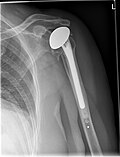Shoulder replacement
Shoulder Replacement is a surgical procedure where the damaged parts of the shoulder are removed and replaced with artificial components, referred to as a prosthesis. The treatment is conducted to relieve pain and improve mobility.
Indications[edit]
Shoulder Replacement is typically recommended for patients suffering from severe forms of arthritis or those who have sustained significant shoulder injuries. The primary goal of the procedure is to relieve pain, with secondary goals including improving motion, strength, and function.
Procedure[edit]
During a Shoulder Replacement procedure, the damaged parts of the shoulder, including the humerus (upper arm bone) and the scapula (shoulder blade), are replaced with artificial components. The procedure is performed under general anesthesia.
Types of Shoulder Replacement[edit]
There are two main types of Shoulder Replacement surgeries: Total Shoulder Replacement and Reverse Total Shoulder Replacement.
Total Shoulder Replacement[edit]
In a Total Shoulder Replacement, the damaged parts of the shoulder are removed and replaced with artificial components. The top of the humerus is replaced with a metal ball and stem, while the shoulder socket is replaced with a plastic socket.
Reverse Total Shoulder Replacement[edit]
In a Reverse Total Shoulder Replacement, the socket and metal ball are switched. This means the metal ball is attached to the shoulder bone and the plastic socket is attached to the upper arm bone. This allows the patient to use the deltoid muscle instead of the torn rotator cuff to lift the arm.
Risks and Complications[edit]
As with any surgery, there are risks associated with Shoulder Replacement. These may include infection, nerve injury, blood clots, and complications from anesthesia.
Recovery[edit]
Recovery from a Shoulder Replacement surgery typically involves physical therapy to improve strength and flexibility in the shoulder. The duration of recovery can vary depending on the individual patient's health and the type of surgery performed.
See Also[edit]
References[edit]
<references />
Ad. Transform your life with W8MD's Budget GLP-1 injections from $75


W8MD offers a medical weight loss program to lose weight in Philadelphia. Our physician-supervised medical weight loss provides:
- Weight loss injections in NYC (generic and brand names):
- Zepbound / Mounjaro, Wegovy / Ozempic, Saxenda
- Most insurances accepted or discounted self-pay rates. We will obtain insurance prior authorizations if needed.
- Generic GLP1 weight loss injections from $75 for the starting dose.
- Also offer prescription weight loss medications including Phentermine, Qsymia, Diethylpropion, Contrave etc.
NYC weight loss doctor appointmentsNYC weight loss doctor appointments
Start your NYC weight loss journey today at our NYC medical weight loss and Philadelphia medical weight loss clinics.
- Call 718-946-5500 to lose weight in NYC or for medical weight loss in Philadelphia 215-676-2334.
- Tags:NYC medical weight loss, Philadelphia lose weight Zepbound NYC, Budget GLP1 weight loss injections, Wegovy Philadelphia, Wegovy NYC, Philadelphia medical weight loss, Brookly weight loss and Wegovy NYC
|
WikiMD's Wellness Encyclopedia |
| Let Food Be Thy Medicine Medicine Thy Food - Hippocrates |
Medical Disclaimer: WikiMD is not a substitute for professional medical advice. The information on WikiMD is provided as an information resource only, may be incorrect, outdated or misleading, and is not to be used or relied on for any diagnostic or treatment purposes. Please consult your health care provider before making any healthcare decisions or for guidance about a specific medical condition. WikiMD expressly disclaims responsibility, and shall have no liability, for any damages, loss, injury, or liability whatsoever suffered as a result of your reliance on the information contained in this site. By visiting this site you agree to the foregoing terms and conditions, which may from time to time be changed or supplemented by WikiMD. If you do not agree to the foregoing terms and conditions, you should not enter or use this site. See full disclaimer.
Credits:Most images are courtesy of Wikimedia commons, and templates, categories Wikipedia, licensed under CC BY SA or similar.
Translate this page: - East Asian
中文,
日本,
한국어,
South Asian
हिन्दी,
தமிழ்,
తెలుగు,
Urdu,
ಕನ್ನಡ,
Southeast Asian
Indonesian,
Vietnamese,
Thai,
မြန်မာဘာသာ,
বাংলা
European
español,
Deutsch,
français,
Greek,
português do Brasil,
polski,
română,
русский,
Nederlands,
norsk,
svenska,
suomi,
Italian
Middle Eastern & African
عربى,
Turkish,
Persian,
Hebrew,
Afrikaans,
isiZulu,
Kiswahili,
Other
Bulgarian,
Hungarian,
Czech,
Swedish,
മലയാളം,
मराठी,
ਪੰਜਾਬੀ,
ગુજરાતી,
Portuguese,
Ukrainian



